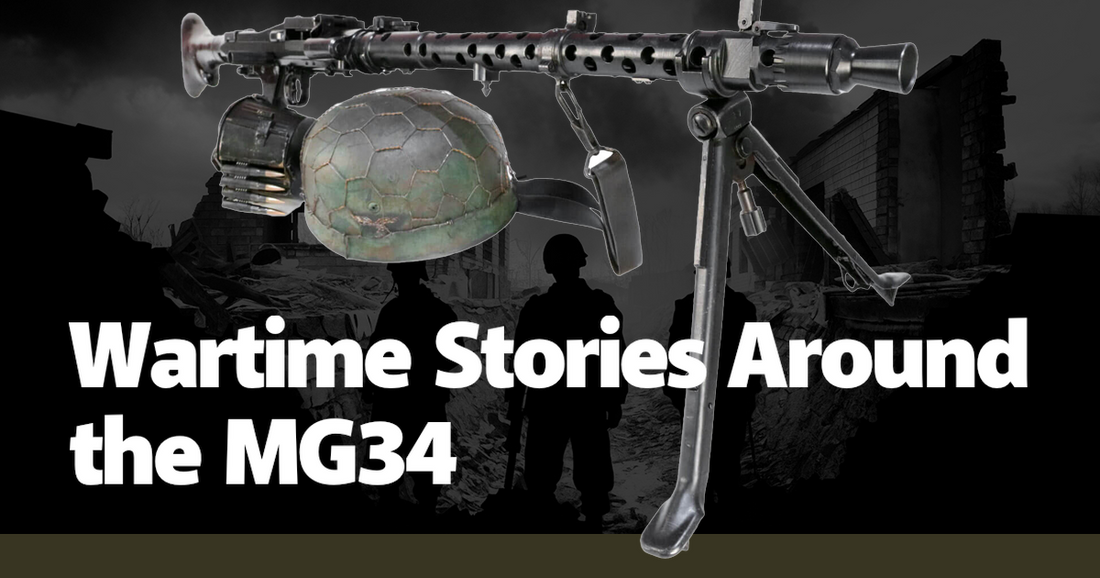The MG34, a German machine gun that saw extensive use during World War II, is a weapon wrapped in legend and steeped in stories of both heroism and horror. Developed in the 1930s, the MG34 was the world's first general-purpose machine gun, capable of being used in a variety of roles—from infantry support to anti-aircraft defense. Its versatility and reliability made it a favorite among German troops, and it quickly became a symbol of the Wehrmacht's tactical prowess. However, the true measure of the MG34's impact can only be understood through the stories of the soldiers who wielded it and the battles it shaped.
One such story comes from the Eastern Front, where the MG34's rapid rate of fire proved both a blessing and a curse. In the brutal winter of 1942, a German machine gun squad found themselves entrenched in the outskirts of Stalingrad, facing relentless Soviet assaults. The MG34, with its ability to fire up to 900 rounds per minute, was their lifeline. As waves of Soviet infantry advanced, the gun's staccato bursts cut through the freezing air, mowing down attackers and buying precious time. Yet, the weapon's high rate of fire also meant that it would quickly overheat, forcing the crew to swap out barrels amidst the chaos of battle. The squad's leader, a seasoned sergeant named Heinrich, later recounted how the MG34 became both their savior and their tormentor, its relentless need for maintenance a constant reminder of their precarious position.
In North Africa, the MG34's adaptability was put to the test in the harsh desert environment. During the Battle of El Alamein, German Afrika Korps units used the MG34 in defensive positions, mounting it on tripods to create interlocking fields of fire. One particularly harrowing account comes from a young gunner named Klaus, who found himself manning an MG34 during a night assault by British forces. As the enemy closed in, Klaus and his team unleashed a torrent of fire, the gun's muzzle flash illuminating the desolate landscape. The MG34's precision and reliability allowed them to repel the attack, but the experience left Klaus with a deep respect for the weapon's lethal efficiency and the grim reality of war.
The MG34 was not only a tool of destruction but also a symbol of innovation and engineering excellence. Its design influenced many post-war machine guns, including the iconic MG42. However, the MG34's complexity also posed challenges. Its intricate mechanism required meticulous care, and in the heat of battle, even a minor malfunction could be catastrophic. A poignant example of this occurred during the Normandy invasion, where a German machine gun team, tasked with defending a crucial position, experienced a jam at a critical moment. The gunner, a veteran named Otto, frantically tried to clear the malfunction as Allied troops advanced. Despite their best efforts, the position was overrun, and Otto's last memories were of the MG34's cold, unyielding metal in his hands—a stark reminder of the fine line between life and death in combat.
The MG34's impact extended beyond the battlefield, influencing the tactics and strategies of both Axis and Allied forces. Its presence forced enemy commanders to adapt, developing new approaches to counter its devastating firepower. In the Italian Campaign, Allied troops learned to recognize the distinctive sound of the MG34 and adjusted their movements accordingly, using smoke and artillery to neutralize its positions. One British officer, reflecting on his experiences, noted that the MG34's psychological effect was as significant as its physical lethality. The mere knowledge that an MG34 was in the vicinity could alter the course of an engagement, instilling a sense of caution and urgency in those who faced it.
Despite its fearsome reputation, the MG34 also had moments of unintended humanity. In the closing days of the war, a German machine gunner named Hans found himself cut off from his unit, hiding in a bombed-out building in Berlin. As Soviet troops closed in, Hans prepared for a final stand with his MG34. However, fate took a different turn when a young Soviet soldier, barely out of his teens, stumbled upon Hans' position. Both men, exhausted and disillusioned, hesitated. In that brief moment, the MG34—an instrument of death—became a silent witness to an unspoken truce. The two soldiers, recognizing the futility of further bloodshed, chose to part ways, each carrying the weight of their experiences and the haunting memories of a war that had consumed their youth.
The legacy of the MG34 is a complex tapestry of technological achievement, tactical innovation, and the human stories that define its history. It serves as a reminder of the dual nature of military technology—capable of both immense destruction and moments of profound humanity. For the soldiers who used it, the MG34 was more than just a tool of war; it was a companion in their darkest hours, a testament to their resilience, and a symbol of the relentless march of history. The stories of the MG34 are not just about a machine gun; they are about the people who lived, fought, and died in its shadow, their lives forever intertwined with the echoes of its gunfire.
In the annals of military history, the MG34 stands as a testament to the ingenuity and brutality of warfare. Its stories, filled with both valor and tragedy, offer a window into the human condition, revealing the complexities and contradictions of those who wielded it. Whether in the frozen trenches of Stalingrad, the scorching deserts of North Africa, or the war-torn streets of Berlin, the MG34 left an indelible mark on the lives of countless soldiers. As we reflect on these wartime stories, we are reminded of the profound impact of technology on the course of history and the enduring spirit of those who endure its trials.

